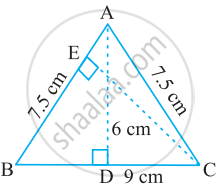Advertisements
Advertisements
Question
Find a relation between x and y, if the points A(2, 1), B(x, y) and C(7,5) are collinear.
Solution
Let `A(x_1 =2,y_1=1),B (x_2 =x,y_2=y) and C (x_3=7,y_3=5` be the given points .
The given points are collinear if
`x_1 (y_2-y_3)+x_2(y_3-y_1)+x_3(y_1-y_2)=0`
`⇒2(y-5)+x(5-1)+7(1-y)=0`
`⇒2y-10+4x+7-7y=0`
`⇒ 4x-5y-3=0`
Hence, the required relation is 4x -5y-3=0
APPEARS IN
RELATED QUESTIONS
Find the values of k so that the area of the triangle with vertices (1, -1), (-4, 2k) and (-k, -5) is 24 sq. units.
If P(–5, –3), Q(–4, –6), R(2, –3) and S(1, 2) are the vertices of a quadrilateral PQRS, find its area.
For what value of x will the points (x, –1), (2, 1) and (4, 5) lie on a line ?
The coordinates of A, B, C are (6, 3), (–3, 5) and (4, – 2) respectively and P is any point (x, y). Show that the ratio of the areas of triangle PBC and ABC is
ΔABC is isosceles with AB = AC = 7.5 cm and BC = 9 cm (see the given figure). The height AD from A to BC, is 6 cm. Find the area of ΔABC. What will be the height from C to AB i.e., CE?

Prove that the lines joining the middle points of the opposite sides of a quadrilateral and the join of the middle points of its diagonals meet in a point and bisect one another
In a ΔABC, AB = 15 cm, BC = 13 cm and AC = 14 cm. Find the area of ΔABC and hence its altitude on AC ?
Let `Delta = abs (("x", "y", "z"),("x"^2, "y"^2, "z"^2),("x"^3, "y"^3, "z"^3)),` then the value of `Delta` is ____________.
The points (0, 5), (0, –9) and (3, 6) are collinear.
Find the missing value:
| Base | Height | Area of parallelogram |
| ______ | 15 cm | 154.5 cm2 |
